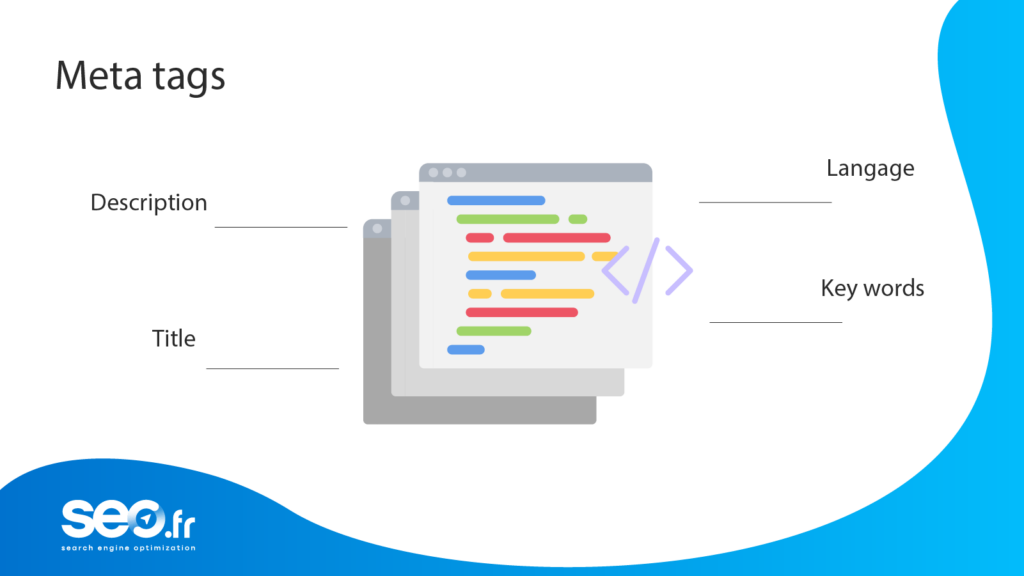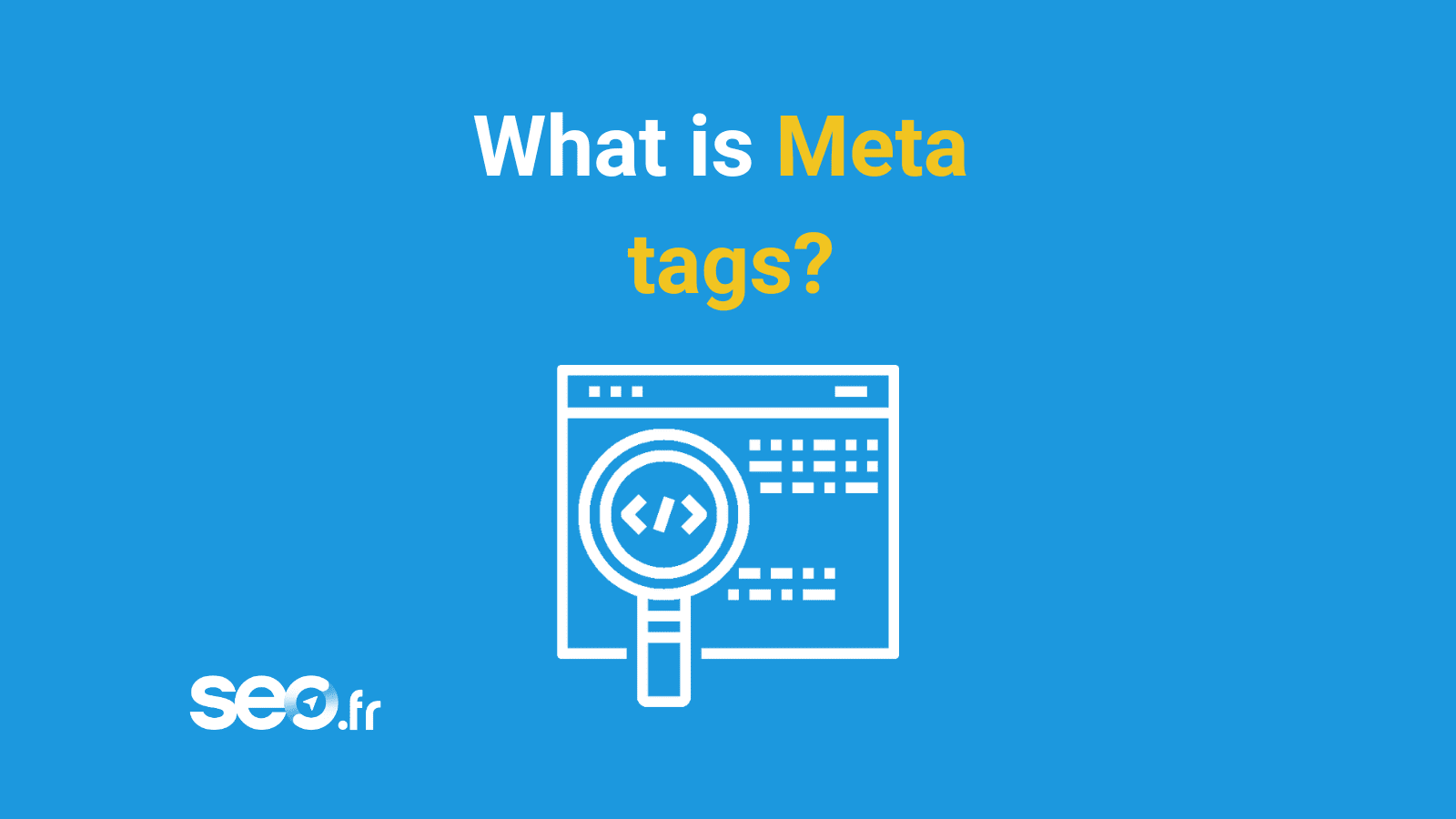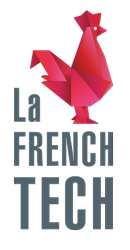Meta tags are part of the code of your pages. Most of these tags are useless for SEO, but some of them are almost indispensable. This page tries to give you a complete overview of the main existing tags, their roles, their syntax and their uses.
What is a “meta” tag?
Meta tags can have several roles:
- Indicate the title of the page and provide a summary of its content
- Inform your visitors’ browsers and/or search engines about the language used in your page, the type of document consulted, the character encoding used, the author of the page…
- Automatically redirect browsers to another page
- Forbidding caching or indexing of the page by the engines
- Etc.
Remember that these tags should be placed in the header of your HTML pages, between the (marking the beginning of the header) and (marking the end of the header) tags. This can be done from your usual HTML editor, or from any text editor (such as Notepad or Wordpad on Windows).
Most meta tags are completely optional, if not unnecessary. The only tags you need to complete are the TITLE tag and the DESCRIPTION tag.
You can use the “robots” meta tag to prevent certain pages from being referenced. You can also use the “Robot.txt” file to achieve this goal.

Roles and syntax
The title tag
For historical reasons (HTML code has a long history…), the title of the page does not appear in a Meta tag. It is simply indicated by the code <title>. However, we wanted to include it here, as it plays a key role in SEO.
This information is used by both browsers and search engines. In many cases, it is this text that represents your page or your site. Take care of it!
Each page MUST have a different title.
TITLE
Page title – 100 characters maximum.
Don’t forget the </Title> tag which indicates the end of the title.
Example : <Title>SEO.fr, your audience analysis </Title>
The meta tags HTTP-EQUIV=”…” CONTENT=”…”
AUTHOR
Author of the page.
Not required field.
Example : <META NAME=”Author” CONTENT=”Zapman, Luc Deborde”>
(several authors possible, separated by commas)
CATEGORY
Category of the page (for directories).
This field is not mandatory.
Example : <META NAME=”Category” CONTENT=”Webmastering, Site management”>
(several values possible, separated by commas)
COPYRIGHT
Copyright(s) of the page.
This field is not required.
Example : <META NAME=”Copyright” CONTENT=”Zapman inc.”>
(several authors possible, separated by commas)
LANGUAGE
Language of the page in the form of an abbreviation (2 letters).
This field is not compulsory and is probably unnecessary (it does not seem to be taken into account by the search engines).
Examples of possible values: “fr ” (French), “en ” (English), “de ” (German), “es ” (Spanish), “it ” (Italian), “pt ” (Portuguese).
The “Content-Language” tag (see below) can also be used to indicate the language.
Example : <META NAME=”Language” CONTENT=”fr”>
DESCRIPTION
Description of the page.
Very useful area. Fill it in! Each page MUST have an independent description!
Between 100 and 1000 characters.
This description is frequently used by the directories that index your site. It is also used to present a summary of your page in the search engine results. So avoid including a series of keywords that are not attractive to Internet users.
Example : <META NAME=”Description” CONTENT=”Role and description of Meta tags”>
DISTRIBUTION
Defines the (public) destination of the documents presented on the page.
Non-mandatory field of little interest. It is probably used by a very few directories.
Possible values: global, local, iu (intranet)
Example : <META NAME=”Distribution” CONTENT=”global”>
GENERATOR
Software(s) used to create the page.
Unnecessary field.
Example : <META NAME=”Generator” CONTENT=”Golive”>
IDENTIFY-URL
Address (url) of the site.
Non-mandatory and of little interest
If you use this zone, put the same URL on all the pages of your site!
KEYWORDS
List of keywords.
Useful area: some directories will use it to index your site. The search engine Voila also seems to take it into account in its rankings.
Only the keywords that appear in the rest of the page will actually be taken into account by the robots.
Example : <META NAME=”Keywords” CONTENT=”Audience analysis, SEO, PageRank, Webmaster”>
PUBLISHER
Person publishing the site.
Useful zone.
This area is (or has been?) taken into account by Google for the relevance of the page.
Example : <META NAME=”Publisher” CONTENT=”Zapman”>
REPLY-TO
Webmaster’s email address.
This can be a useful field. Be careful with the email address you put here: spammers will get it and you will receive a lot of spam at this address.
REVISIT-AFTER
Minimum time desired between 2 robot visits.
Useless zone (it does not seem to be taken into account by the current engines)
Example : <META NAME=”Revisit-After” CONTENT=”30 days”>
ROBOTS
Indexing permission for robots.
If this tag does not exist, the robots will behave as if it did exist and have the value “all”.
Possible values: index (this page will be indexed), noindex (this page will be ignored), follow (links will be followed by the engines), nofollow (do not follow links)
The value “all” is equivalent to “Index,follow”.
The value “none” is equivalent to “noindex,nofollow”.
Example : <META NAME=”Robots” CONTENT=”all”>
GOOGLEBOT
Autorisation de mise en cache spécifique à Google.
La valeur « noarchive » interdit à Google de stocker la page en cache.
Example : <META NAME=”GOOGLEBOT” CONTENT=”NOARCHIVE”>
SEO training?
Sylvain is here for you
16 years’ expertise in digital marketing

The meta tags HTTP-EQUIV=”…” CONTENT=”…”
TYPE
Defines the character set to be used.
By default, the Western character set (text/html; charset=utf-8) will be used.
Example : <META http-equiv=”Content-Type”
content= “text/html; charset=utf-8″>
LANGUAGE
Language of the site.
Possible values:
fr: French
en: English or American
de: German German
es: Spanish
it: Italian
pt: Portuguese
If your page is in several languages, separate these codes with commas.
Example : <META http-equiv=”Content-Language” content=”fr”>
REFRESH
Reload (refresh) the page automatically every n seconds.
<META http-equiv=”Refresh” content=”10″> (for 10 secondes)
OR
Automatically redirect the browser to another page after n seconds.
PRAGMA
Prohibit the page from being saved in the cache of search engines and browsers.
Exemple : <META http-equiv=”Pragma” CONTENT=”no-cache”>









